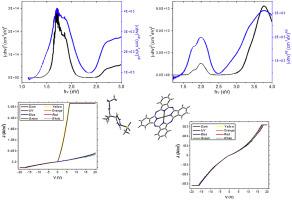当前位置:
X-MOL 学术
›
J. Mol. Struct.
›
论文详情
Our official English website, www.x-mol.net, welcomes your
feedback! (Note: you will need to create a separate account there.)
Comparison of interaction mechanisms of lead phthalocyanine and disodium phthalocyanine with functionalized 1,4 dihydropyridine for optoelectronic applications
Journal of Molecular Structure ( IF 4.0 ) Pub Date : 2020-10-01 , DOI: 10.1016/j.molstruc.2020.128525 María Elena Sánchez-Vergara , Nelia Díaz-Ortega , Héctor J. Maldonado-Ramírez , R. Ballinas-Indili , Citlalli Rios , Roberto Salcedo , C. Álvarez-Toledano
Journal of Molecular Structure ( IF 4.0 ) Pub Date : 2020-10-01 , DOI: 10.1016/j.molstruc.2020.128525 María Elena Sánchez-Vergara , Nelia Díaz-Ortega , Héctor J. Maldonado-Ramírez , R. Ballinas-Indili , Citlalli Rios , Roberto Salcedo , C. Álvarez-Toledano

|
Abstract In the current work, the compound 2-methyl-N-octadecyl-2-(1-((trifluoromethyl)sulfonyl)-1,4-dihydropyridin-4-yl) propanamide was synthesized and characterized. Subsequently, its structure was optimized by DFT (Density Functional Theory) and its interaction with the chosen phthalocyanines: lead phthalocyanine (PbPc) and disodium phthalocyanine (Na2Pc) were also theoretically studied. The energy values of the HOMO (Highest Occupied Molecular Orbital) and the LUMO (Lowest Unoccupied Molecular Orbital), as well as the band gap were obtained from the resulting complex and a semiconductor behavior was found. Based on the theoretical results, bulk heterojunction films were manufactured with the aim of using them as semiconductor active layers in optoelectronic devices. In those films, the bandgap was determined through their absorption coefficients and the energy values of the photon, the results were compared to the theoretical bandgap previously calculated. Finally, the electrical behavior of the electronic donor-acceptor active layers was evaluated in form of simple devices with a heterojunction arrangement. The evaluation of the current-voltage (I–V) was carried out under the presence of different lighting conditions and the devices showed the curve of a typical semiconductor. No variations between the forward and reverse operation zones were shown by the devices, not even when they were exposed to different illumination sources. In general, an ohmic behavior was observed. Results demonstrated that 2-methyl-N-octadecyl-2-(1-((trifluoromethyl)sulfonyl)-1,4-dihydropyridin-4-yl) propenamide can be used as an electron acceptor species for the manufacture of semiconductor active layers of optoelectronic devices.
中文翻译:

酞菁铅和酞菁二钠与官能化 1,4 二氢吡啶在光电应用中的相互作用机制比较
摘要 在目前的工作中,合成并表征了化合物2-甲基-N-十八烷基-2-(1-((三氟甲基)磺酰基)-1,4-二氢吡啶-4-基)丙酰胺。随后,通过 DFT(密度泛函理论)优化了其结构,并对其与所选酞菁的相互作用进行了理论研究:酞菁铅 (PbPc) 和酞菁二钠 (Na2Pc)。HOMO(最高占据分子轨道)和 LUMO(最低未占据分子轨道)的能量值以及带隙是从所得复合物获得的,并发现了半导体行为。根据理论结果,制造了体异质结薄膜,目的是将它们用作光电器件中的半导体有源层。在那些电影中,带隙是通过它们的吸收系数和光子的能量值确定的,将结果与先前计算的理论带隙进行比较。最后,以具有异质结排列的简单器件的形式评估电子供体-受体活性层的电学行为。电流-电压 (I-V) 的评估是在不同光照条件下进行的,器件显示出典型半导体的曲线。这些设备没有显示出正向和反向操作区之间的差异,即使它们暴露在不同的照明源下也是如此。通常,观察到欧姆行为。结果表明,2-甲基-N-十八烷基-2-(1-((三氟甲基)磺酰基)-1,
更新日期:2020-10-01
中文翻译:

酞菁铅和酞菁二钠与官能化 1,4 二氢吡啶在光电应用中的相互作用机制比较
摘要 在目前的工作中,合成并表征了化合物2-甲基-N-十八烷基-2-(1-((三氟甲基)磺酰基)-1,4-二氢吡啶-4-基)丙酰胺。随后,通过 DFT(密度泛函理论)优化了其结构,并对其与所选酞菁的相互作用进行了理论研究:酞菁铅 (PbPc) 和酞菁二钠 (Na2Pc)。HOMO(最高占据分子轨道)和 LUMO(最低未占据分子轨道)的能量值以及带隙是从所得复合物获得的,并发现了半导体行为。根据理论结果,制造了体异质结薄膜,目的是将它们用作光电器件中的半导体有源层。在那些电影中,带隙是通过它们的吸收系数和光子的能量值确定的,将结果与先前计算的理论带隙进行比较。最后,以具有异质结排列的简单器件的形式评估电子供体-受体活性层的电学行为。电流-电压 (I-V) 的评估是在不同光照条件下进行的,器件显示出典型半导体的曲线。这些设备没有显示出正向和反向操作区之间的差异,即使它们暴露在不同的照明源下也是如此。通常,观察到欧姆行为。结果表明,2-甲基-N-十八烷基-2-(1-((三氟甲基)磺酰基)-1,











































 京公网安备 11010802027423号
京公网安备 11010802027423号